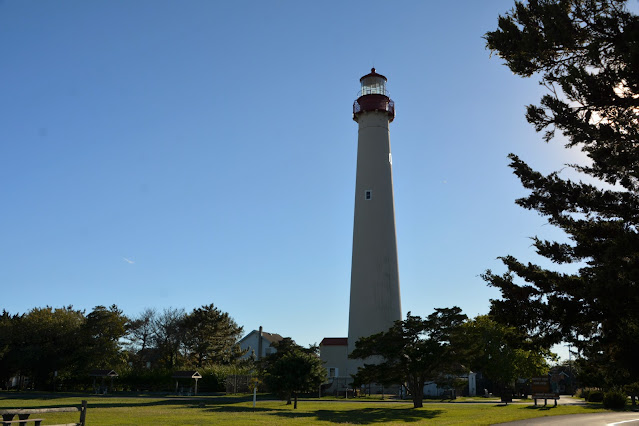Cape May Lighthouse and dwellings in 1933
Photograph courtesy U.S Coast Guard
A deed dated April 8, 1858 records the sale of an additional two acres of land by Alexander Whilden to the government so a taller and proper tower could be constructed at Cape May to display a first-order light to mark the entrance to Delaware Bay. The third Cape May lighthouse would be very similar to New Jersey’s other tall towers, Absecon and Barnegat Lighthouses, which were respectively activated on January 15, 1857 and January 1, 1859. George Meade had overseen work on the other two towers, but Cape May was constructed under the direction of Captain Willam F. Raynolds, followed by Captain W. B. Franklin and Major Hartman Bache. While the other two coastal towers stood over 170 feet tall, Cape May was several feet shorter, but still a respectable 157’ 6”. Access to the tower was through a two-story vestibule, which had an oil room on each side of the passageway on its first floor, and a storage room on its second floor. The illuminating apparatus for the third Cape May Lighthouse was a first-order, Henry-Lepaute Fresnel lens, which had sixteen flash panels and revolved to produce a white flash every thirty seconds. The lamp atop the lighthouse was lit for the first time on Halloween, 1859, and the following year, two keeper’s dwellings, positioned near the lighthouse, were completed. The one-and-a-half-story structures had three rooms and an entry in the first story, and four rooms upstairs.
The Lighthouse Service decided to automate Cape May in June 1933, and Keeper Palmer, who had spent many years at the lighthouse, was allowed to retire with pension. Rather than leave his familiar home, Palmer remained at the station with his wife and two adult daughters and looked after the property.
Cape May Light fell dark during the World War II years, and in 1946 the Fresnel lens was dismantled, removed from the tower, and loaned to the Cape May County Historical Museum, where it can be seen by the public. A rotating aerobeacon replaced the historic lens. In 1964, the lighthouse grounds were turned over to the State of New Jersey, which created Cape May Point State Park. One of the keeper’s dwellings, which had been converted into a duplex in 1903, burned in an arson's fire in 1968, but the second dwelling stills stands and houses park personnel. The Coast Guard, not wanting to maintain the lighthouse, leased the tower to the state in 1986, and then transferred ownership of the station in 1992.
Height:157 feet (48 m), Range: 24 nautical miles (44 km), Characteristic: White-flashes every 15 seconds

















No comments:
Post a Comment